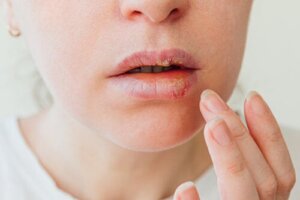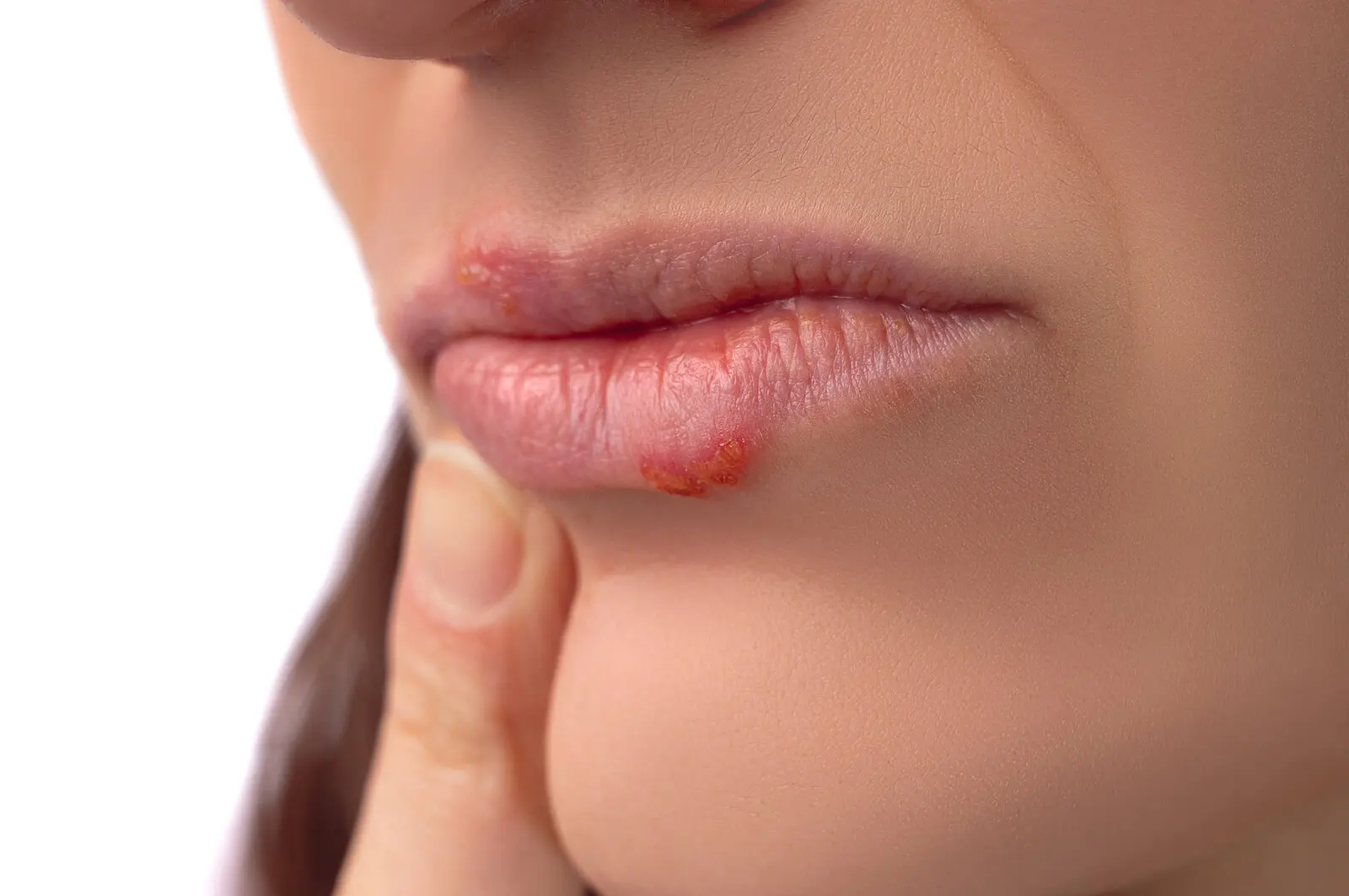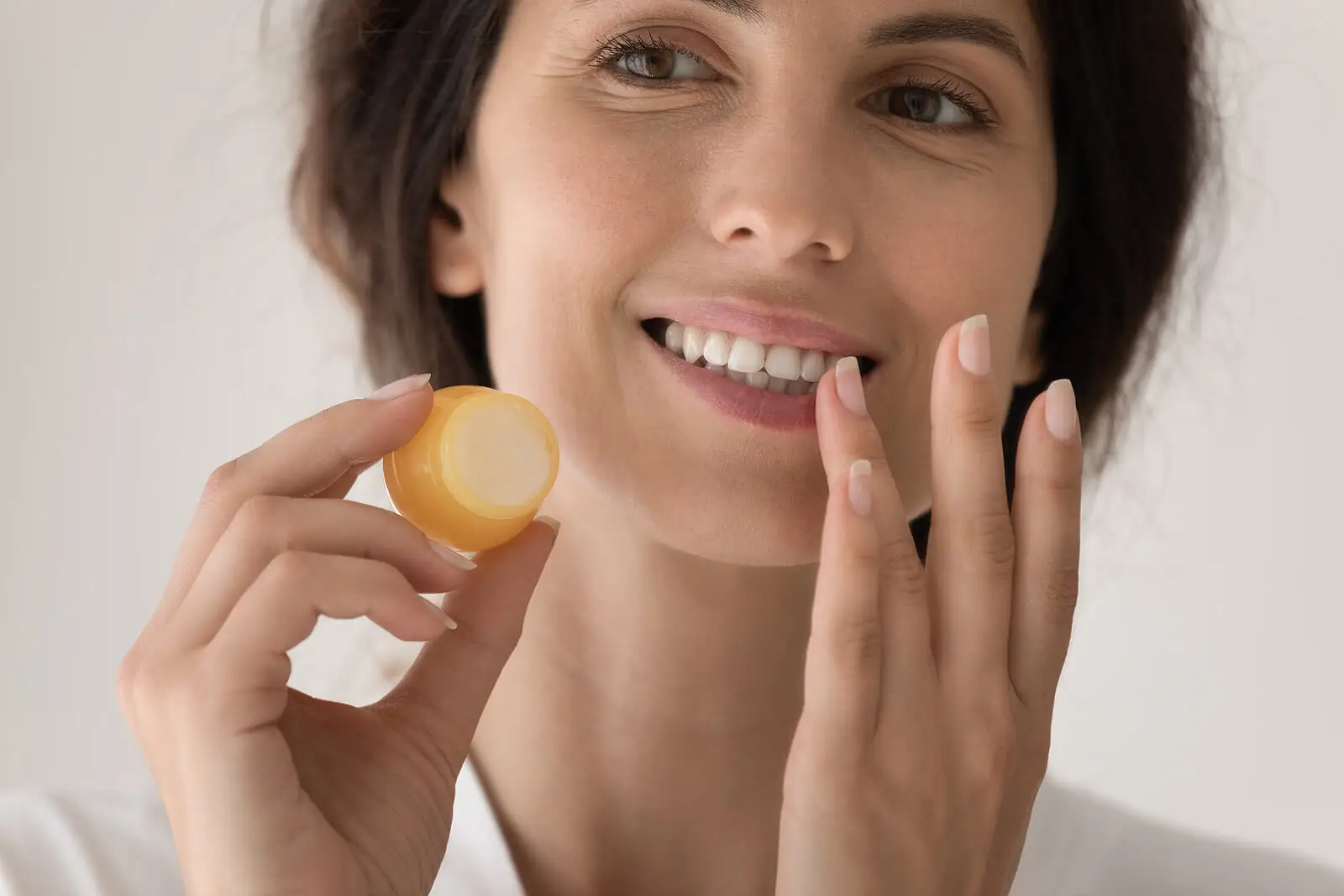Treatment for sore throats


Written and verified by the dentist Vanesa Evangelina Buffa
Angular cheilitis are lesions that appear on the corners of the lips. They’re also commonly known as “sore throats” and can have different causes. Stress, diet, and some germs are some of the most frequent causes. In any case, it’s possible to address them with prevention and treatment for sore throats.
Often, sore throats begin to manifest themselves with dryness and redness at the corners of the lips. Although they can be short-lived, they sometimes become chronic. In any case, it’s important to consult a doctor or dentist for appropriate treatment. Let’s have a look at the therapeutic options in detail.
What are sore throats?
As we have already mentioned, what’s commonly called a “sore throat” is what’s known in dentistry as “angular cheilitis“. It’s the inflammation of the labial commissure, which is the angle where the upper lip meets the lower lip.
In general, it’s associated with excessive moisture in the area. For this reason, young children and the elderly are the age groups most affected. In children, drooling and reduced ability to swallow saliva are usually the triggers. This tends to be frequent when teeth are coming through
However, in older adults, it’s usually caused by the typical wrinkles of old age. If teeth have been lost and the mouth hasn’t recovered, these folds in the mouth are usually more marked and favor the formation of sore throats.
Its main clinical manifestations are the reddening of the area and the presence of small fissures or wounds. The latter are usually covered with a yellowish or white membrane. This is a crust that is moistened by saliva.
Other symptoms may include the following:
- A bad odor when opening the mouth (halitosis)
- Tightness or pain when eating acidic, salty, or spicy foods
- Discomfort when opening the mouth
- Deep wounds that bleed (in severe cases)
According to whether the cold sore is located in only one corner or in both corners, it can be classified as follows:
- Unilateral angular cheilitis
- Bilateral angular cheilitis

Find out more here: Improve Your Oral Health with Coconut Oil
What are the causes of sore throats?
When choosing the best treatment for sore throats, it’s very important to find what caused them. Because of that, we’ll now tell you why these lesions appear on the lips.
We have already mentioned that one of the most common causes is the accumulation of moisture in the area, especially in babies and the elderly. The large amount of saliva on the lips favors the proliferation of fungi and bacteria. To be more precise, the saliva that is retained on the corners of the lips dries and cracks the epithelial tissue. It then becomes moist again, thus becoming an environment conducive to the colonization of germs.
Constant moisture and the proliferation of pathogenic microorganisms trigger the inflammatory process that characterizes the condition. Candida yeasts and bacteria of the staphylococcus group are the most common culprits. There are some situations specific to the mouth or to health in general that predispose certain people to develop these lesions. We’ll tell you about the most frequent factors that have been identified as risk factors:
- Edentulism. The lack of teeth changes the physiognomy of the face, decreases the vertical dimension of the mouth and favors the formation of wrinkles and folds that get wet and hurt.
- Wearing ill-fitting dentures or having poorly positioned teeth.
- Dry mouth or skin dryness.
- A weak immune system, which could be linked to having diabetes, HIV, inflammatory bowel disease or Down syndrome.
- Suffering from nutritional deficiencies, especially iron, zinc or vitamins A, B and C.
- Developing allergies to certain foods or cosmetic products.
- Having undergone major weight loss in a relatively short period of time.
- Exposure to very low or high temperatures.
- Pregnancy hormonal changes.
- Stress, anxiety or emotional problems.
- Frequent lip licking.
- Medications. Frequent use of antibiotics or application of retinoid products.
- Harmful habits, such as smoking.
Prevention and treatment for sore throats
To choose an ideal treatment against sore throats it is necessary to see a doctor, dermatologist or dentist. The professional will determine the exact cause and, depending on this, will choose one treatment option or another.
In principle, a physical examination of the mouth will be carried out and other irritations that have appeared on the skin will be examined. An interview will also be necessary to find out about habits, diet, lifestyle, and medications used.
As fungal or bacterial infection is quite common, the physician may decide to take a culture sample for analysis. However, this step is usually left for when the usual treatments and care for sore throats haven’t been successful.
Depending on the underlying cause, the practitioner will address the problem in the following ways:
- If it’s due to a nutritional problem, dietary changes or the use of specific supplements such as iron, folic acid or vitamin B12 will be necessary.
- When the cold sore is related to dry mouth, good hydration, the use of sugar-free chewing gum or artificial salivawill be indicated.
- Treatments against wrinkles with filler injections may be appropriate in cases of very marked folds.
- If dental malpositions or maladapted dentures are involved, timely dental treatment will improve the situation.
- In cases of allergies, the triggering product should be identified and discontinued. The prescribing of anti-allergic drugs can improve the situation.
- If the origin was extreme temperatures, use a lip balm and avoid exposure to cold or intense sunlight again.
- If they’re associated with stress or anxiety, recovering mental well-being will be part of the therapy.
In addition to these solutions that respond to the origin of the problem, the physician will indicate specific treatments and care against sore throats. Let’s see in detail.
Topical local medication
When sore throats are infected by bacteria or fungi, medication will be necessary to fight the germs. These are topical creams containing antifungals or antibiotics.
In addition, ointments containing steroids may be indicated. These creams reduce discomfort and inflammation. In some cases, ointments containing a combination of antifungals, antibiotics, and corticosteroids are used.
The professional may also indicate the use of a topical antiseptic or mouthwash to clean the wounds and promote healing. Chlorhexidine is the most common. If the product is a gel, it can be placed directly on the wound. On the other hand, if it’s a liquid, it should be applied with a swab or gauze.
It’s also advisable to use healing creams containing benzalkonium chloride, zinc oxide, or vitamins A and D. These moisturize, heal and mitigate inflammation. In turn, they exert a barrier action on the area and insulate it from moisture. Thus, skin regeneration is accelerated and healing is improved.
Systemic medication
Although not the most common, the physician may consider it appropriate to use systemic medication to treat sore throats. This usually occurs in cases where the patient’s immunity is compromised.
Depending on the circumstances, the practitioner will prescribe antifungal capsules for fungus-infected cheilitis. And if the wound has been colonized by bacteria, antibiotics will be prescribed.
Other care and treatments for sore throats
A homemade way to promote tissue recovery is to eat foods that reduce irritation in the area. Avoiding salty, spicy, acidic food, as well as alcohol will protect the wound and prevent discomfort. Other measures are as follows:
- Keep the wound dry and hydrated
- Avoid licking or nibbling the area
- Don’t open the mouth excessively so that the lesions can close better.
- Using lip balm, petroleum jelly, or coconut oil to waterproof the area and promote healing.

How to avoid sore throats?
Lip skin care is very important to keep this area of the mouth healthy. Its hydration and elasticity will prevent it from breaking easily when yawning, talking, or eating. The use of lip creams or lip balms is a great help.
It’s also a good idea to practice the following:
- Keep the area dry. Avoid licking or soaking the skin with the tongue.
- Be cautious with the sun and cold. Take care of the area with sunscreen.
- Adopt a healthy and varied diet that provides sufficient vitamins and minerals.
- Have an adequate oral and body hygiene in general.
Discover more here: Cold Sore Characteristics and Treatment
Reliable treatment for sore throats
As you have seen, angular cheilitis is an inflammation that affects the corners of the mouth. Fortunately, it can be controlled with simple treatments and care. However, it’s always a good idea to see a doctor or dentist, especially if the lesions don’t disappear after 2 weeks, or if they worsen or reappear.
All cited sources were thoroughly reviewed by our team to ensure their quality, reliability, currency, and validity. The bibliography of this article was considered reliable and of academic or scientific accuracy.
- Raposo Correa, S., & Jiménez, P. (2016). QUEILITIS ANGULAR. A PROPÓSITO DE UN CASO TRAS INGESTA DE ANTIBIÓTICOS ORALES. Revista Europea de Odontoestomatología, 3-6.
- Carrasco, W., Guerra, M. E., & Tovar, V. (2008). Comparacion de la presencia de queilitis angular en niños VIH (+) y VIH (-), hijos de madres seropositivas. Acta Odontológica Venezolana, 46(3), 260-264.
- de Seguro Social, C. C. (2016). Manual familiar para la salud bucodental.
- García Alpizar, B., Benet Rodíguez, M., & Castillo Betancourt, E. (2010). Prótesis dentales y lesiones mucosas en el adulto mayor: una preocupación de todos. MediSur, 8(1), 36-41.
- Park, K. K., Brodell, R. T., & Helms, S. E. (2011). Angular cheilitis, part 1: local etiologies. Cutis, 87(6), 289-295.
- García López, E., Blanco Ruiz, A. O., Rodríguez García, L. O., Reyes Fundora, D., & Sotres Vázquez, J. (2004). Queilitis: Revisión bibliográfica. Revista Cubana de Estomatología, 41(2), 0-0.
- Hermoso, C. M. C., Morales, P. A. M., Sánchez, S. B., & Clavijo, M. C. (2004). Sobreinfección por Candida spp y Estafilococo aureus en pacientes con queilitis angular. Universitas Odontologica, 24(54-55), 26-30.
- Rosario, L. Y., Marella, L. L., Thomas, K., & Gogineni, A. (2014). What causes cheilitis, and how do you treat it?. Evidence-Based Practice, 17(5), E8-E9.
- Bhutta, B. S., & Hafsi, W. (2021). Cheilitis. In StatPearls [Internet]. StatPearls Publishing.
- Federico, J. R., Basehore, B. M., & Zito, P. M. (2019). Angular Chelitis.
- Brevis Palma, C. P., & Carrasco Jorquera, D. A. (2020). Antifúngicos convencionales y terapias alternativas o complementarias para la candidiasis oral: revisión narrativa.
This text is provided for informational purposes only and does not replace consultation with a professional. If in doubt, consult your specialist.








